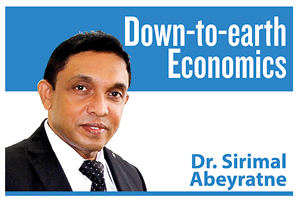Believe it or not: We need inflation!
View(s):
File picture of a vegetable market in Poland.
When we save money, we should receive an interest; it is the “reward” for postponing our consumption. And when we borrow money, we should pay interest; in this case, it is the “cost” of buying someone else’s money. These are the general economic rules that we all understand.
Imagine its opposite; savings have a “cost” and borrowings give a “reward”. It is the case of “negative” interest rates! Over the past few years, the central banks of some advanced countries have been pushing their policy rates down to zero or even below zero levels: Japan, Sweden, Switzerland, Denmark, and the Euro area, all have adopted this weird tactic over the past 3 – 4 years.
When the interest rate rises, money becomes expensive; then we don’t want to borrow, but to save. When the interest rate falls money becomes cheaper; then we are tempted to borrow more and save less.
But can it go too far to the extent that the borrowers are rewarded and depositors are penalized? In doing so, why does anyone want to turn the general rules of money upside down? Since it has already become a reality now, let’s shed some light on this issue today.
Zero or negative rates
Since the early 2016 the Bank of Japan has maintained its key short-term interest rate negative at –0.1 per cent. The Swiss National Bank started its zero benchmark interest rate in 2011, and then its negative rate in 2015 which remained so far at –0.75.
The Central Bank of Sweden also reduced its repo rate below zero in 2015, and maintained the negative rate at –0.5 per cent since early 2016; during the past few month of 2019, this repo rate remained at –0.25. The benchmark interest rate in Denmark was lowered below zero since 2013 and, remained negative at -0.65 since early 2016.
In all countries in the Euro area, the policy rate is the benchmark refinancing rate determined by the European Central Bank. Since early 2016, this interest rate has been maintained at 0 per cent.
Buying bonds
When the “policy rates” which apply to short-term transactions between the commercial banks and their bank – the Central Bank – are low, naturally all other deposit and lending rates in the money market move in the same direction resulting in zero or negative interest rates.
The impact of the zero or negative interest rates is first felt by the commercial banks which have to deal with their Central Bank. The depositors or lenders in this case are the commercial banks which deposit their money at or lend to the Central Bank; now they have to pay for that if the policy rates are negative.
There was a time when the central banks in these countries were injecting money – in fact, in massive amounts -, through the purchase of bonds. This has driven the bond yield down. For instance, 10-year bond yield in all these countries fell down to near zero and, sometimes even below zero levels. This means, if you decide to put your money in bonds, you might gain nothing or, perhaps, you might lose too.
Money shouldn’t return
After all, these central banks never wanted the money that they injected through buying bonds to come back again to the Central Bank; that is, actually to the commercial bank deposits maintained at the Central Bank. It is a reversal of the policy.
Zero or negative interest rate policy discourages money flowing back to the central banks. The target is that the money that was injected should be spent and invested. Therefore, commercial banks are encouraged or rather forced to lend competitively which would drive down the market interest rates too.
Common problem
The common problem for all these countries with zero and negative interest rates was the fear of deflation and slower economic growth – symptoms of economic recession. While these countries haven’t fully recovered from the global financial crisis in 2008-2009, Japan has been in a long recession for the past 25 years.
Deflation is the fall in prices. All these countries have a common goal of achieving “inflation” which appears to be bizarre from our point of view. We might be happy to imagine a situation with falling prices, but deflation is perhaps worse than inflation. It is more dangerous for a country to be trapped in deflation.
Tomorrow is better
When a country is trapped in a deflationary situation such as Japan did, people expect that prices will be lower tomorrow than today, and in the future than at present. This means that there will be a continuous postponement of spending!
People will postpone their daily purchases to tomorrow or to next week. Somewhat longer-term purchases such as clothing, jewellery, and durables will be postponed to next month or to next year. Buying a house, a motor car or a property will be postponed to much longer times. Imports will not grow. Borrowings and investment will not grow either.
When people keep postponing their spending decisions, the prices also actually keep falling continuously. Then it becomes difficult for the country to get out of deflation! As a result of postponing spending, businesses would not expand and growth begins to slow down too.
People in Japan used to save more compared with many other countries in the world. The problem gets worse when there is a negative population growth and a rapidly ageing population – Japan has got that too. It makes the matters even worse as shrinking populations tend to buy less, and it is difficult to push spending with older people who want to save.
Breaking the impasse
Zero and negative interest rate policies discourage savings, and encourage spending and investment. While injecting money into the economy, the central banks of those countries which adopt such zero and negative interest rate policies direct their commercial banks to lend at competitively lower rates using their excess liquidity.
As spending and investment rise, it is expected that prices would go up on the one hand, and for economic growth to accelerate on the other hand.
Did prices and output respond to the zero and negative interest rates? It is expected that the answers to this question are debatable. Apparently there was no consistency in the achievements of inflation and economic growth, while there were other factors which influenced the achievements in either direction.
 In all the countries, fall in prices slowed down, and the annual inflation remained above 0 per cent and, sometime even above 1 per cent level. However, the achievement in economic growth was not much encouraging; in all of the countries the rate of real GDP growth continued to remain as low as 0 – 1 per cent per annum, and volatile.
In all the countries, fall in prices slowed down, and the annual inflation remained above 0 per cent and, sometime even above 1 per cent level. However, the achievement in economic growth was not much encouraging; in all of the countries the rate of real GDP growth continued to remain as low as 0 – 1 per cent per annum, and volatile.
Money outflows
One of the important factors that counteract zero and negative interest rate policies was the money outflows. Money was excessive and too cheap within the country so that at least part of it gushed out to other countries driving up the Asian stock markets and bond markets.
By the way, we should not forget the US interest rate policy episode during the same period of time. The US Federal Reserve Bank moved in the opposite direction. It started pushing its Federal Fund Rate upward; it was 0.25 per cent in late 2015, and increased to 2.5 per cent by the end of 2018.
The increased interest rates in the US was more than an open invitation for cheap money in Japan and Europe which was seeking better locations for financial investment. Instead of increased spending and investment at home, at least part of the injected money flowed into US dollar assets. (The writer is a Professor of Economics at the University of Colombo and can be reached at sirimal@econ.cmb.ac.lk).


